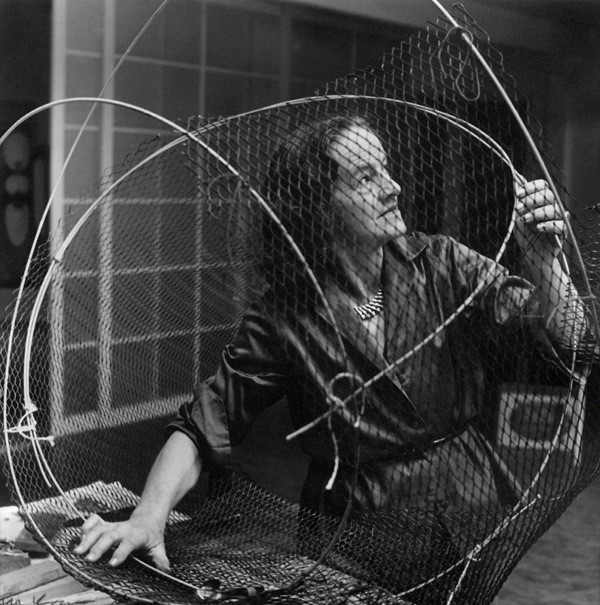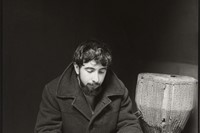“Artist with a camera,” was how one newspaper described Ida Kar in its coverage of the Whitechapel’s 1960 survey of her work, which was also the first major photographic exhibition to be held at a London gallery.
“Artist with a camera,” was how one newspaper described Ida Kar in its coverage of the Whitechapel’s 1960 survey of her work, which was also the first major photographic exhibition to be held at a London gallery. Born in Armenia, Kar lived and studied in Alexandria and Paris before settling in London with her English husband Victor Musgrave, who ran Gallery One off the Charing Cross Road. Throughout the fifties and early sixties, Kar had sittings with everyone from Eugène Ionesco, Jean-Paul Sartre and Iris Murdoch, to Man Ray, Henry Moore and Augustus John. Now, after a ten year project cataloguing the Kar archive of 10,000 negatives, the National Portrait Gallery is holding the largest exhibition of her work since the Whitechapel retrospective. Exhibition curator Clare Freestone tells AnOther about Kar’s life and style, and how she fought to have photography taken seriously as an art form, at a time when it was still considered the domain of reportage.
Kar photographed her subjects surrounded by their tools and creations – books, paintbrushes, sculptures. How would you describe her style?
I call her photographs environmental portraits – they give you clues into people's lives. By all accounts she had an instinctive vision and her way of working reflects her personality, which was warm-hearted, but could also offend. She only took half an hour to arrange a sitting, and she had a way of putting people at ease, despite driving them mad sometimes. Her husband said about her in a piece written for the Knoedler Kasmin Gallery in 1982:"omniverous and vulnerable both, her voice and eyes allied with the extraordinary things she said could win people’s hearts or provoke them to fury. Few remained indifferent to her, nor would she have wished them to. She had something of the temperament of a Piaf or a Billie Holiday and originally trained in Paris to be a singer."
The exhibition title, Ida Kar: Bohemian Photographer, alludes to how she established a community of artists around her, wherever she lived...
There was certainly a Bohemian scene around Gallery One, above which she had her studio. Musgrave was a champion of those working outside the mainstream. He's recognised for bringing Yves Klein to London, giving Bridget Riley her first exhibition, F.N. Souza was one of the gallery's star artists, and he gave Gillian Ayres her first solo show. She and Musgrave had a very open marriage and her lodger, author Colin MacInnes, based Absolute Beginners on one of Kar's assistant/lovers, of which she had a few. The book is a picture of Bohemian Soho: writers, artists, prostitutes, visiting Armenians, all sitting around the table eating together. Apparently Kar was a great cook. Despite poverty she often had caviar sent from Armenia for breakfast.
How did she feel about having to do commercial work?
She saw herself as a great artist, so as long as the commissions didn't take her away from what she really enjoyed doing, which was photographing artists and writers, it was fine. I think she liked working for the Tatler. One of her most successful commissions for them was Le Quartier St Ives, a series of portraits from the artists’ community in Cornwall.
How significant was the Whitechapel exhibition for her – and for the acceptance of photography as art?
It was very important to her career. The Whitechapel at the time was well-respected under the leadership of Bryan Robertson, who had mounted the first major British exhibition of Jackson Pollock’s work just two years before. Kar was fighting the corner that photography is a real art form, which was a major critical discussion at the time.
Why do you think her popularity waned?
Changing fashions in photography: Bailey, Donovan, Duffy. She was already middle-aged when she prospered in London, so age and ill-health affected her work in later years. Hopefully this exhibition will show her for the talent that she was, as well as her significant contribution to the history of photography.
Were there any surprise finds while cataloguing the archive?
We found over 50 negatives of the Auto-Destructive artist Gustav Metzer in a box that was incorrectly labelled – really great period pieces. The one we've included in the exhibition shows him outside Gallery One at the time of the 1962 Fluxus exhibition, Festival of Misfits, which was also held at the ICA. As far as we know, these photos have never been exhibited before.
Ida Kar: Bohemian Photographer at the National Portrait Gallery until 19 June 2011.
Ananda Pellerin is a London-based writer and the Editor of Wheel Me Out.



